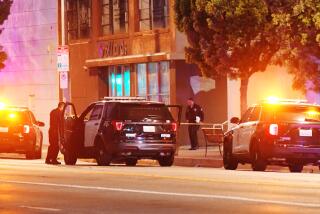Ex-LAPD Partners Targeted in Probe
Federal authorities are investigating a 1999 incident in which a Los Angeles police officer fired shots at a 14-year-old drug suspect and then was accused of planting a gun to justify his actions.
FBI agents and lawyers in the Los Angeles U.S. attorney’s office have questioned at least one current and one former LAPD officer who were present on the night of the Feb. 8, 1999, shooting in South Los Angeles. LAPD Officer William Ferguson fired at the teenager who allegedly pointed a gun at him through the window of a crack house. Ferguson missed, but the city paid out $1.7 million to settle a lawsuit growing out of the case, which has drawn the attention of federal authorities and others.
Occupants of the house gave authorities an account of the event that diverged in several places from the one detailed in police reports, and a number of investigations are attempting to get to the bottom of the case.
The former officer questioned by federal prosecutors is Jeffrey Robb, who was Ferguson’s partner at the time of the shooting. Together, those two officers were known on the streets as Batman and Robin. Robb was granted limited immunity before giving a statement to federal prosecutors in an interview last month, according to his lawyer, Paul DePasquale. The lawyer declined to comment on what Robb told investigators.
FBI agents have also interviewed a second LAPD officer, who responded to a call for backup on the night of the shooting and ended up firing two shots at Ferguson, whom he mistook for a suspect.
The federal probe is the latest investigation to be launched regarding that shooting and its aftermath. The LAPD’s inspector general, Jeffrey C. Eglash, is looking into the Police Department’s handling of the case, specifically the question of whether members of the city’s Police Commission had all the necessary information when they concluded that the shooting was within LAPD policy.
Though the Police Commission’s look at the case has implications for department procedures, the federal probe carries potentially more serious consequences. Federal law makes it a crime for police officers to violate the civil rights of suspects.
Federal investigators are examining the shooting as part of wide-ranging corruption probe of Ferguson and Officer Ruben Palomares. Palomares was not at the scene of the 1999 shooting but he and Ferguson have been friends for several years; Palomares is in federal custody in San Diego on cocaine trafficking charges.
According to LAPD officials, authorities are investigating allegations that Ferguson, Palomares and others robbed drug dealers at gunpoint. Palomares has also been identified as a suspect in the murder of a young man in Huntington Park but has not been charged in that case. Attorneys for Palomares and Ferguson deny the allegations against their clients.
The federal involvement in the case comes after it has bounced from one prosecutor to another in the district attorney’s office for more than two years. The case remains under review by the district attorney, but according to one prosecutor familiar with the investigation, there has been little headway.
According to the official police report of the shooting, Ferguson and Robb were conducting a routine narcotics investigation at a known crack house when Frank Harris, 14, pointed a gun at Ferguson, who fired in self-defense but did not hit the youth.
The occupants in the house, however, said the officers tried to provoke the shooting by banging on the doors and windows and identifying themselves first as rival gang members and then as police.
A tape recording of a 911 call by one of the house’s occupants suggests that those inside were in fact confused about who it was outside that night.
“Hey lady,” resident Magellon Harmon said to the emergency dispatcher, “get somebody over here. We don’t know if they’re real cops or not.”
Harris and others in the house that night said that the teenager was unarmed and that police planted a gun in a bedroom, then later claimed the weapon belonged to Harris. Shortly after the shooting, LAPD investigators became concerned that Ferguson was engaged in possibly criminal activity. Investigators obtained a search warrant for his police locker and found a replica handgun that, in the opinion of one detective, was most likely possessed by Ferguson to be used as “planted evidence.’
In November, the city agreed to pay $1.7 million to settle a civil lawsuit filed by Harris and others who claimed they were tormented by the officers.
During pretrial depositions in the case, both Ferguson and Robb refused to testify about details of the shooting, citing their constitutional rights against self-incrimination.
DePasquale would not say what prompted Robb to give a statement to federal authorities last month.
Also interviewed about the shooting was Officer Ernest Berry, who is still assigned to the Southeast Division.
The investigations into the 1999 shooting have turned up other possible leads as well, according to sources familiar with the case. After an article about the shooting in The Times in August, LAPD Sgt. David Loera approached internal affairs investigators, saying he had information about the shooting.
Loera’s purpose in coming forward was to dispute a claim made by a fellow sergeant who said he witnessed Ferguson plant a gun on the night of the shooting, investigators said.
Loera told investigators that he also was present but did not see Ferguson plant a weapon.
But he did tell the investigators about the discovery of a “Pendelton-type jacket” found on the ground near where Ferguson had been standing.
Unbeknownst to Loera, Ferguson had previously been accused of wearing a similar jacket to conceal his identity as an officer and be able to sneak up on suspects.
More to Read
Sign up for Essential California
The most important California stories and recommendations in your inbox every morning.
You may occasionally receive promotional content from the Los Angeles Times.











